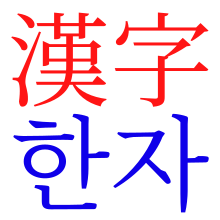| Hanja | |
|---|---|
 | |
| Script type | Logographic
|
Time period | 400 BC – present |
| Languages | Korean, Classical Chinese |
| Related scripts | |
Parent systems | |
Sister systems | Kanji, traditional Chinese, simplified Chinese, Khitan script, Chữ Hán, Chữ Nôm, Jurchen script, Tangut script |
| ISO 15924 | |
| ISO 15924 | Hani (500), Han (Hanzi, Kanji, Hanja) |
| Unicode | |
Unicode alias | Han |
| Hanja | |
| Hangul | 한자 |
|---|---|
| Hanja | 漢字 |
| Revised Romanization | Hanja |
| McCune–Reischauer | Hancha |
 |
| Korean writing systems |
|---|
| Hangul |
|
| Hanja |
| Mixed script |
| Braille |
| Transcription |
| Transliteration |
Hanja (Korean: 한자; Hanja: 漢字, Korean pronunciation: [ha(ː)ntɕ͈a]), alternatively known as Hancha, are Chinese characters used to write the Korean language. After characters were introduced to Korea to write Literary Chinese, they were adapted to write Korean as early as the Gojoseon period.
Hanja-eo (한자어, 漢字語) refers to Sino-Korean vocabulary, which can be written with Hanja, and hanmun (한문, 漢文) refers to Classical Chinese writing, although Hanja is also sometimes used to encompass both concepts. Because Hanja characters have never undergone any major reforms, they more closely resemble traditional Chinese and traditional Japanese characters, although the stroke orders for certain characters are slightly different. Such examples are the characters 教 and 敎, as well as 研 and 硏.[1] Only a small number of Hanja characters were modified or are unique to Korean, with the rest being identical to the traditional Chinese characters. By contrast, many of the Chinese characters currently in use in mainland China, Malaysia and Singapore have been simplified, and contain fewer strokes than the corresponding Hanja characters.
Until the contemporary period, Korean documents, history, literature and records were written primarily in Literary Chinese using Hanja as its primary script. As early as 1446, Sejong the Great promulgated Hangul (also known as Chosŏn'gŭl in North Korea) through the Hunminjeongeum. It did not come into widespread official use until the late 19th and early 20th century.[2][3] Proficiency in Chinese characters is, therefore, necessary to study Korean history. Etymology of Sino-Korean words are reflected in Hanja.[4]
Hanja were once used to write native Korean words, in a variety of systems collectively known as idu, but by the 20th century Koreans used hanja only for writing Sino-Korean words, while writing native vocabulary and loanwords from other languages in Hangul. By the 21st century, even Sino-Korean words are usually written in the Hangul alphabet, with the corresponding Chinese character sometimes written next to it to prevent confusion if there are other characters or words with the same Hangul spelling. According to the Standard Korean Language Dictionary published by the National Institute of Korean Language (NIKL), approximately half (50%) of Korean words are Sino-Korean, mostly in academic fields (science, government, and society).[5] Other dictionaries, such as the Urimal Keun Sajeon, claim this number might be as low as roughly 30%.[6][7]
- ^ "Korean Hanja Characters". SayJack. Retrieved 4 November 2017.
- ^ 알고 싶은 한글. National Institute of Korean Language. Retrieved 22 March 2018.
- ^ Fischer, Stephen Roger (4 April 2004). A History of Writing. Globalities. London: Reaktion Books. pp. 189–194. ISBN 1-86189-101-6. Retrieved 3 April 2009.
- ^ Byon, Andrew Sangpil (2017). Modern Korean Grammar: A Practical Guide. Taylor & Francis. pp. 3–18. ISBN 978-1351741293.
- ^ Choo, Miho; O'Grady, William (1996). Handbook of Korean Vocabulary: An Approach to Word Recognition and Comprehension. University of Hawaii Press. pp. ix. ISBN 0824818156.
- ^ 사전소개 | 겨레말큰사전남북공동편찬사업회. www.gyeoremal.or.kr (in Korean). Retrieved 23 November 2022.
- ^ 우리말 70%가 한자말? 일제가 왜곡한 거라네. The Hankyoreh (in Korean). 11 September 2009. Retrieved 23 November 2022.
